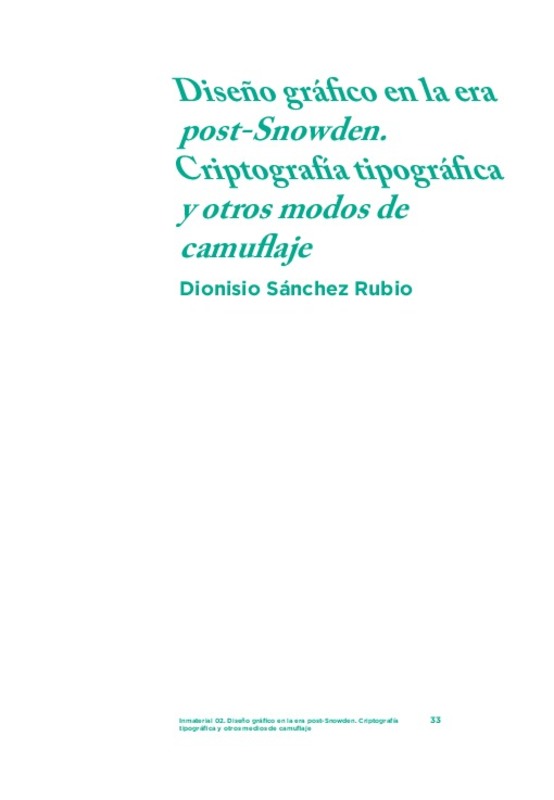JavaScript is disabled for your browser. Some features of this site may not work without it.
Buscar en RiuNet
Listar
Mi cuenta
Estadísticas
Ayuda RiuNet
Admin. UPV
Diseño gráfico en la era post-Snowden. Criptografía tipográfica y otros modos de camuflaje
Mostrar el registro sencillo del ítem
Ficheros en el ítem
| dc.contributor.author | Sanchez-Rubio, Dionisio
|
es_ES |
| dc.date.accessioned | 2018-05-24T04:23:54Z | |
| dc.date.available | 2018-05-24T04:23:54Z | |
| dc.date.issued | 2016 | es_ES |
| dc.identifier.uri | http://hdl.handle.net/10251/102500 | |
| dc.description.abstract | [ES] La nueva vigilancia impuesta por parte de gobiernos y corporaciones es una de las mayores problemáticas a las que se enfrenta la sociedad contemporánea. El desarrollo de Internet y la aparición de nuevas tecnologías que posibilitan la monitorización de nuestros datos en Red, ha propiciado un cambio de paradigma en la gestión de la información afectando directamente a nuestra privacidad. Ante esta realidad, cabe preguntarse cómo se puede hacer frente al abuso de poder al que nos vemos sometidos y qué podemos hacer para abrir un espacio de resistencia que nos permita tomar conciencia sobre la problemática. Los diseñadores gráficos, como operadores culturales generadores de material simbólico, están realizando muchas aportaciones que cuestionan los modos de vigilancia en la era post-Snowden. Desde el diseño crítico, las prácticas especulativas y el activismo, han surgido diferentes proyectos que utilizan la tipografía y se apropian de las técnicas de encriptación, para aportar una mirada crítica sobre el control social que va más allá de posibles usos pragmáticos o utilitarios. Nuestra aproximación a estas prácticas demuestra el creciente interés por parte de los diseñadores gráficos en los estudios sobre la vigilancia, viendo las conexiones entre tipografía y privacidad. Para ello hemos analizado el concepto de control social y las repercusiones que tiene en nuestra sociedad. Por último, se ha realizado un estudio de los proyectos Project Seen de Emil Kozole, ZXX de Sang Mun y Typographic Obfuscation de Chris Lange, pues son cruciales para poder entender la relación entre encriptación, esteganografía y tipografía. | es_ES |
| dc.description.abstract | [EN] New surveillance modes imposed by governments and corporations is one of the biggest problems faced by contemporary society. The development of the Internet and the emergence of new technologies that make the monitoring of our data throughout the network possible, has led to a paradigm shift in the management of information, which directly affects our privacy. Faced with this situation we might wonder how the abuse of power to which we find ourselves subjected can be tackled and what we can do to open up a resistance zone that allows us to become aware of the problem. Graphic designers, as cultural operators and generators of symbolic material, are making numerous contributions that question surveillance modes in the post-Snowden era. From critical design, speculative practices and activism, different projects have emerged which use typography and adopt encryption techniques to provide a critical view of social control that goes beyond any pragmatic or utilitarian use. Our approach to these practices demonstrates the growing interest of graphic designers in the study of monitoring, seeing the connections between typography and privacy. To this end we have analysed the concept of social control and the impact it has on our society. Lastly, a study of the following projects has been carried out: Project Seen by Emil Kozole, ZXX by Sang Mun and Typographic Obfuscation by Chris Lange, given that they are crucial to understanding the relationship between encryption, steganography and typography. | es_ES |
| dc.language | Español | es_ES |
| dc.publisher | Bau, Centro Universitario de Diseño de Barcelona | es_ES |
| dc.relation.ispartof | Inmaterial. DISEÑO, ARTE Y SOCIEDAD | es_ES |
| dc.rights | Reconocimiento - No comercial - Sin obra derivada (by-nc-nd) | es_ES |
| dc.subject | Comunicación visual | es_ES |
| dc.subject | Encriptación | es_ES |
| dc.subject | Vigilancia | es_ES |
| dc.subject | tipografía | es_ES |
| dc.subject | Esteganografía | es_ES |
| dc.subject.classification | ESCULTURA | es_ES |
| dc.title | Diseño gráfico en la era post-Snowden. Criptografía tipográfica y otros modos de camuflaje | es_ES |
| dc.type | Artículo | es_ES |
| dc.rights.accessRights | Abierto | es_ES |
| dc.contributor.affiliation | Universitat Politècnica de València. Departamento de Escultura - Departament d'Escultura | es_ES |
| dc.description.bibliographicCitation | Sanchez-Rubio, D. (2016). Diseño gráfico en la era post-Snowden. Criptografía tipográfica y otros modos de camuflaje. Inmaterial. DISEÑO, ARTE Y SOCIEDAD. 1(2):33-67. http://hdl.handle.net/10251/102500 | es_ES |
| dc.description.accrualMethod | S | es_ES |
| dc.relation.publisherversion | https://www.inmaterialdesign.com/index.php/mag/index | es_ES |
| dc.description.upvformatpinicio | 33 | es_ES |
| dc.description.upvformatpfin | 67 | es_ES |
| dc.type.version | info:eu-repo/semantics/publishedVersion | es_ES |
| dc.description.volume | 1 | es_ES |
| dc.description.issue | 2 | es_ES |
| dc.identifier.eissn | 2462-5892 | es_ES |
| dc.relation.pasarela | S\322933 | es_ES |






